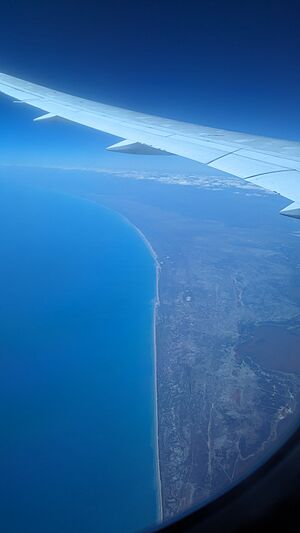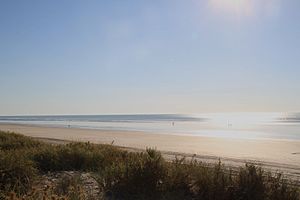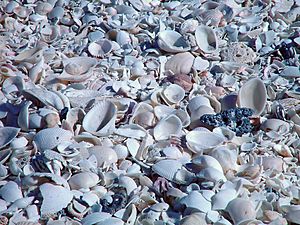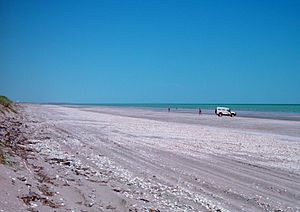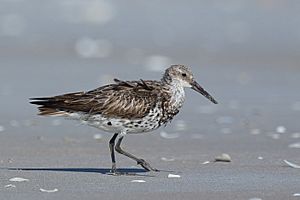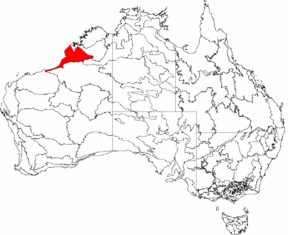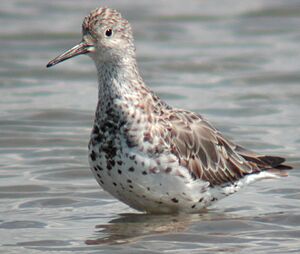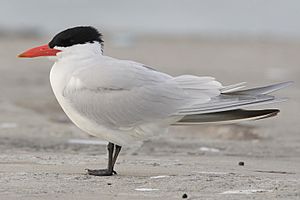Eighty Mile Beach facts for kids
Quick facts for kids
Designations
|
|
| Official name: Eighty-mile Beach | |
| Designated: | 7 June 1990 |
|---|---|
| Reference #: | 480 |
Eighty Mile Beach, also spelled Eighty-mile Beach or 80-mile Beach, is a very long beach in Western Australia. It lies along the north-west coast, about halfway between the towns of Broome and Port Hedland. Even though it's called "Eighty Mile Beach," it's actually about 220 kilometers (137 miles) long! This makes it one of the longest beaches in the world.
This beach is a super important place for many shorebirds (also called waders) that migrate across Australia. Because of its importance, it's recognized as a special wetland under the Ramsar Convention on Wetlands.
Contents
History of Eighty Mile Beach
Traditional Owners and Their Stories
The southern part of Eighty Mile Beach belongs to the Nyangumarta people. They have a strong connection to this area. Many of their songs, stories, and ceremonies are about places along the beach. In 2009, a court decided that the Nyangumarta People are the rightful traditional owners of this part of the beach.
The northern part of Eighty Mile Beach is shared by the Nyangumarta People and the Karajarri People. In the Karajarri language, the beach is called Wender. This means "a creaking noise," which describes the sound of walking on dry sand.
Many Aboriginal people who are connected to this area now live at the Bidyadanga Community. There are also special water sources behind the beach called lirri. These were very important for fresh water in the past.
Why the Name Changed
The beach was known as "90-mile Beach" until 1946. The name was changed to "Eighty Mile Beach" to avoid confusion. There was another beach in Victoria, Australia, already called Ninety Mile Beach, Victoria.
Military Activities Here
The Talgarno military base, near Anna Plains, was important after World War II. It was used to track and recover British Blue Streak rockets. These rockets were tested from Woomera, South Australia. Today, you can still see an airstrip and concrete buildings there. In 1999, the Department of Defence tested a missile from Anna Plains. This was for the Jindalee over-the-horizon radar project.
Studying Shorebirds at the Beach
Eighty Mile Beach is a very important place for shorebirds. It's known as an Important Bird Area (IBA). Over 400,000 shorebirds regularly visit this beach! This includes many types of birds like bar-tailed godwits and great knots.
Since 1981, groups like the Australasian Wader Studies Group have visited almost every year. They band and count shorebirds. This helps them learn about the birds' populations. Since 1992, they have also added special leg-flags to the birds. This helps them discover the exact paths the birds take when they migrate.
About Eighty Mile Beach
Geography of the Beach
Eighty Mile Beach is located in the Shire of Broome. This is in the Kimberley region of Western Australia. The beach stretches in a gentle curve from Cape Missiessy to Cape Keraudren.
The beach is about 100 meters (328 feet) wide. It has a gentle slope and is made of sand with many shells. The tides here are very big, changing by up to 9 meters (30 feet). Next to the beach are wide mudflats, which can be 1 to 5 kilometers (0.6 to 3 miles) wide.
Behind the beach, you'll find sand dunes. Further inland, there's a narrow flat area and then a strip of pindan woodland or shrubland. Most of the land along the coast is covered by large pastoral leases. These are big farms mainly used for raising cattle.
Climate of the Area
The climate here is semi-arid and monsoonal. This means it has a hot, wet summer and a warm, dry winter. The average rainfall is about 327 to 341 millimeters (13 to 13.4 inches) per year. However, the amount of rain can change a lot from year to year. Much of the rain comes from tropical cyclones, especially from January to March.
Eighty Mile Beach: A Ramsar Site
About 1750 square kilometers (676 square miles) of the beach and nearby land, including the Mandora Marsh, were named Ramsar Site 480 on June 7, 1990. This means it's a wetland of international importance.
Plants and Animals of Eighty Mile Beach
Plants You Can Find
Along the beach, the main sand dunes are held in place by plants like green birdflower and beach spinifex. Other plants like dune wattle grow on the ridges behind the dunes. Some important grasses include Whiteochloa airoides and Triodia epactia. Inland grasslands have changed a lot because of cattle grazing. Now, they are mostly covered by introduced grasses like buffel grass.
Amazing Animals
The main reason Eighty Mile Beach is so special is because of the huge numbers of shorebirds. It's one of the most important places for these birds to rest and feed. They come here during their long migrations from northern Asia and Alaska. They spend the southern summer in Australia.
This beach is especially important for the migration of the great knot bird. It supports at least 1% of the total population of 17 different wader species and the Caspian tern. The most common shorebirds here are the great knot (up to 169,000 birds), bar-tailed godwit (110,000), and red knot (80,000). Other birds you might see include curlew sandpipers, red-necked stints, and large sand plovers.
Flatback turtles also nest along Eighty-mile Beach. They lay their eggs between October and April. The coastal plains near Anna Plains Station are home to many Australian bustards and red kangaroos. The western part of Wallal Downs has a lot of euros (a type of wallaroo).
Mandora Marsh Wetland
Mandora Marsh, also called the Mandora Salt Marsh, is a special wetland area. It's part of an old river system. It's located on Mandora Station, about 30 kilometers (19 miles) from Eighty Mile Beach. Even though it's part of the Eighty Mile Beach Ramsar Site, it has its own unique plants and animals.
Visiting Eighty Mile Beach
More and more people are visiting Eighty Mile Beach. There's a caravan park on Wallal Downs, which is one of the ways to get to the beach. It's about 250 kilometers (155 miles) north of Port Hedland and 365 kilometers (227 miles) south of Broome. People come here for fishing, collecting seashells, and other fun beach activities.



